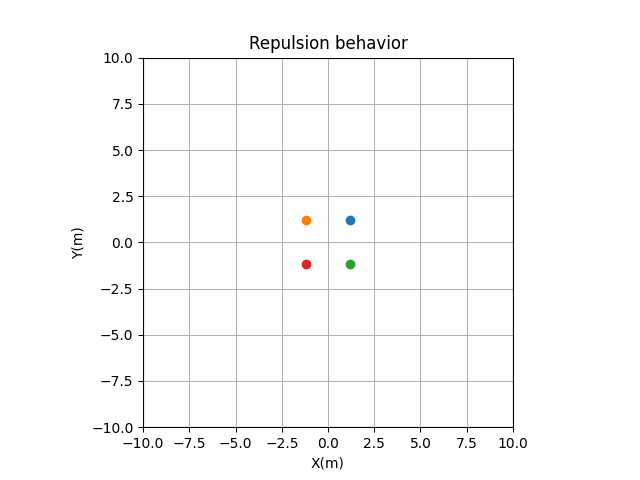Welcome to pyswarming’s documentation!

Introduction
pyswarming is a research toolkit for Swarm Robotics.
Install
You can install pyswarming from PyPI using pip (Recommended):
pip install pyswarming
Dependencies
pyswarming’s dependencies are: numpy, numdifftools and matplotlib.
Algorithms covered
This library includes the following algorithms to be used in swarm robotics:
Leaderless heading consensus: the collective performs heading consensus [1];
Inverse power: ajustable attraction and repulsion laws [2];
Spring: allows the robots to maintain a desired distance between them [2];
Force law: mimics the gravitational force [3];
Repulsive force: makes the individuals repulse each other [4];
Body force: introduces a body force that considers the radii of the robots [4];
Inter robot spacing: allows the robots to maintain a desired distance between them [5];
Dissipative: a dissipative force that reduces the “energy” of the robots [5];
Leader following: the collective performs heading consensus with a leader [6];
Collision avoidance: the robot stays away from neighbors in the vicinity [7];
Attraction alignment: the robot becomes attracted and aligned [7];
Preferred direction: the robot has a preference to move toward a preset direction [7];
Lennard-Jones: allows the formation of lattices [8];
Virtual viscosity: a viscous force that reduces the “oscillation” of the robots [8];
Modified attraction alignment: the robot becomes attracted and aligned by considering a “social importance” factor [9];
Heading consensus: the collective performs heading consensus [10];
Perimeter defense: the robots maximize the perimeter covered in an unknown environment [10];
Environment exploration: provides spatial coverage [10];
Aggregation: makes all the individuals aggregate collectively [11];
Alignment: the collective performs heading consensus [11];
Geofencing: attract the robots towards area A [11];
Repulsion: makes all the individuals repulse collectively [11];
Target: the robot goes to an specific target location [11];
Area coverage: using the Geofencing and Repulsion algorithms [11];
Collective navigation: using the Target and Repulsion algorithms [11];
Flocking: using the Aggregation, Repulsion and Alignment algorithms [11];
References
Examples using pyswarming.swarm
Repulsion (low-code)
For this example we will use a low-code approach, i.e., pyswarming.swarm, for details, see the examples or the notebooks folder.
# importing the swarm creator
import pyswarming.swarm as ps
# creating the swarm
my_swarm = ps.Swarm(n = 10, # number of robots
linear_speed = 0.5, # linear speed of each robot
dT = 1.0, # sampling time
deployment_point_limits = [[0.0, 0.0, 0.0], [5.0, 5.0, 0.0]], # lower and upper limits for the position deployment
deployment_orientation_limits = [[0.0, 0.0, 0.0], [0.0, 0.0, 2*3.1415]], # lower and upper limits for the orientation deployment
distribution_type = 'uniform', # type of distribution used to deploy the robots
plot_limits = [[-50.0, 50.0], [-50.0, 50.0]], # plot limits x_lim, y_lim
behaviors = ['repulsion']) # list of behaviors
my_swarm.simulate()

Respulsion (without low-code)
Considering a swarm of robots, they can show different behaviors by using pyswarming, for details, see the examples or the notebooks folder.
# importing pyswarming behaviors
import pyswarming.behaviors as pb
# importing numpy to work with arrays
import numpy as np
# importing matplotlib to plot the animation
import matplotlib.pyplot as plt
import matplotlib.animation as animation
# importing functools.partial to use in the animation
from functools import partial
# define each robot (x, y, z) position
robot_poses = np.asarray([[1., 1., 0.],
[-1., 1., 0.],
[1., -1., 0.],
[-1., -1., 0.]])
# set the robot linear velocity
robot_speed = 0.025
# First set up the figure, the axis, and the plot element we want to animate
fig, ax = plt.subplots()
ax.set_xlim([-10,10])
ax.set_ylim([-10,10])
ax.set_xlabel('X(m)')
ax.set_ylabel('Y(m)')
ax.grid()
ax.set_aspect('equal')
ax.set_title('Repulsion behavior')
robot1, = ax.plot([], [], marker='o', lw=0)
robot2, = ax.plot([], [], marker='o', lw=0)
robot3, = ax.plot([], [], marker='o', lw=0)
robot4, = ax.plot([], [], marker='o', lw=0)
# initialization function: plot the background of each frame
def init():
robot1.set_data([], [])
robot2.set_data([], [])
robot3.set_data([], [])
robot4.set_data([], [])
return (robot1,robot2,robot3,robot4,)
# animation function. This is called sequentially
def animate(i, robot_poses):
for r_ind in range(len(robot_poses)):
r_i = robot_poses[r_ind]
r_j = np.delete(robot_poses, np.array([r_ind]), axis=0)
robot_poses[r_ind] += robot_speed*pb.repulsion(r_i, r_j, 5.0)
robot1.set_data(robot_poses[0][0], robot_poses[0][1])
robot2.set_data(robot_poses[1][0], robot_poses[1][1])
robot3.set_data(robot_poses[2][0], robot_poses[2][1])
robot4.set_data(robot_poses[3][0], robot_poses[3][1])
return (robot1,robot2,robot3,robot4,)
# call the animator. blit=True means only re-draw the parts that
# have changed.
anim = animation.FuncAnimation(fig, partial(animate, robot_poses=robot_poses), init_func=init,
frames=480, interval=1, blit=True)
anim
plt.show()
